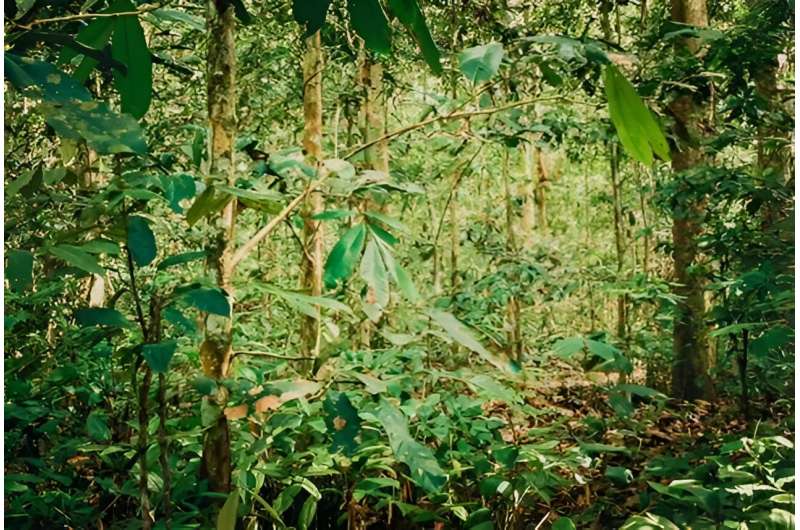This article has been reviewed according to Science X's editorial process and policies. Editors have highlighted the following attributes while ensuring the content's credibility:
fact-checked
trusted source
proofread
Study reveals uniqueness of naturally occurring monodominant forests in the Republic of Congo

A recent study published in the journal Plant Ecology and Evolution gives valuable insights into forest stands of Gilbertiodendron dewevrei (G. dewevrei) in the Sangha Trinational region.
G. dewevrei, known as "Bemba" or "Limbali" forest by Indigenous peoples and local communities, is a tree species endemic to the Congo Basin that is unusual in forming large stands where it is almost the only species present. The study focuses on the comparative analysis of the structure and composition of this G. dewevrei forest type compared to adjacent forest types.
Using data from plot inventories and herbarium specimens, researchers evaluated several parameters, including stem density, basal area, aboveground biomass, stem size class distribution, species diversity, and species composition. The study results revealed significant differences between the two forest types. The G. dewevrei forest has a lower stem density but a higher proportion of large trees, suggesting higher carbon stocks.
Consequently, the findings suggest that the G. dewevrei forest should be considered separately in conservation planning and carbon stock calculations. "This study underscores the importance of recognizing the G. dewevrei forest as a distinct ecosystem in our conservation and natural resource management efforts. By gaining a deeper understanding of the characteristics of this forest, we can enhance our ability to protect it and contribute to biodiversity conservation," said Richard Malonga, country director of WCS Congo.
Led by Ellen Heimpel, and David J. Harris, this research was conducted by the Royal Botanic Garden of Edinburgh in collaboration with WCS Congo, with support from the Ministry of Forestry Economy, the Ministry of Scientific Research and Technological Innovation of the Government of Congo, as well as the Congolese Agency for Wildlife and Protected Areas (ACFAP).
"In this paper, we show that Gilbertiodendron dewevrei forest is distinct from mixed forest in both species composition and in forest structure. It contains a unique community of plant life and may store more carbon than other mixed species forest. We believe that this is an important forest type to conserve," noted Ellen Heimpel, a Ph.D. student at the Royal Botanic Garden Edinburgh.
Dr. David J. Harris added, "Limbali forest is widespread across the northern Republic of Congo, southern Central African Republic, parts of Cameroon and DRC. The more we understand about this forest, the better we can make sure its value can be reflected in policies on forests in the Congo Basin."
Future research steps will include a deeper exploration of the factors influencing species associations within the G. dewevrei forest, as well as comparisons with other regions where this species is present. Mapping the extent of G. dewevrei forests in the Congo Basin is also a priority for effective conservation planning.
More information: Ellen Heimpel et al, Floristic and structural distinctness of monodominant Gilbertiodendron dewevrei forest in the western Congo Basin, Plant Ecology and Evolution (2024). DOI: 10.5091/plecevo.111539
Provided by Wildlife Conservation Society





















